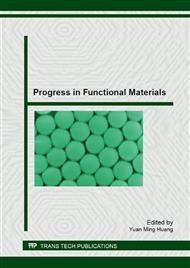p.165
p.169
p.173
p.177
p.181
p.185
p.189
p.193
p.197
Photo- and Thermo-Dual-Responsive Organic/Inorganic Hybrid Materials
Abstract:
Organic/inorganic hybrid materials based upon stimuli-responsive copolymers have attracted an inceasing attention. Compared with the polymeric materials, these hybrid materials can form aggregates in aqueous solution with much more stable shape-persistance due to the inorganic structure, which facilitate the mass delivery and long-term life. A novel hybrid material based on a new reactive block copolymer, poly(ethylene oxide)-block-poly{3-(trimethoxysilyl)propyl methacrylate-co-N-isopropylacrylamide-co-6-[4-(4-methoxyphenylazo)phenoxy]hexyl methacrylate} [PEO-P(TMSPMA-NIPAM-AzoMA)] was synthesized via atom transfer radical polymerization (ATRP). The vesicles were obtained by self-assembly of the resulting block copolymer in a selective solvent, and then the PTMSPMA block was subjected to hydrolysis and polycondensation reaction to fix vesicle wall in the presence of triethylamine as a catalyst. The photo- and thermo- dual-responsive properties of the vesicles were investigated.
Info:
Periodical:
Pages:
181-184
Citation:
Online since:
January 2013
Authors:
Price:
Сopyright:
© 2013 Trans Tech Publications Ltd. All Rights Reserved
Share:
Citation:


